|
|
|
FT. MCHENRY POWDER HORN MINIATURE ART
|
| |
|
|
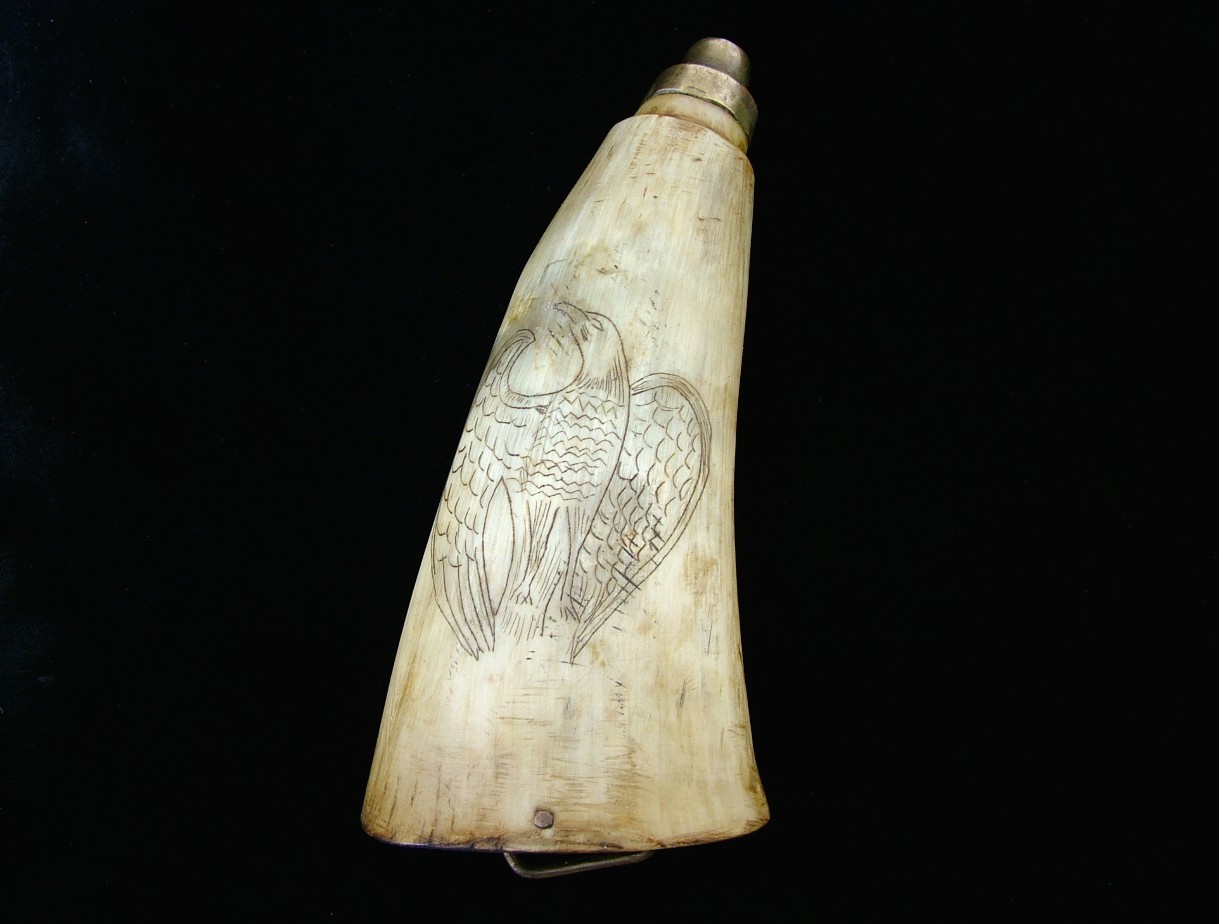
| Photo Copyright 2008 |
| David Xavier Kenney |
|
NEW INFO WITH A POSSIBLE LEAD FOR THE STORY OF JOHN HONEYMAN "GEORGE WASHINGTON'S SPY":
The new Information with this artifact is that miniature art has been found on the inside of the powder horn, this art may provide a lead with the story of the Revolutionary War Spy John Honeyman (aka "George Washington's Spy"). First is should be mentioned that some of the art on the powder horn's wooden butt plate (and on the horn itself) are of Washington's Crossing of the Delaware and a transference of that event to the 1814 defenders of Baltimore and Ft. McHenry. There are hints that the wood used for making this butt plate may have originated from a "relic" of the Crossing of the Delaware and, or the Battle of Trenton on Dec 25th/26th, 1776. The new information with miniature art is on one end of the butt plate inside the powder horn. I do not have the equipment to photograph this area or pictures would be provided, I can only mention that as the art is on the inside has been better protected it is in excellent condition. It shows an animal tail with an open tail tip (somewhat like a ribbed line with a slightly crescent openwork spearhead for a tip) coming from where the butt plate meets the horn. In front of the tail's tip is an engraved Hessian soldier (ID'd by a distinct mitre hat), inside the opening of the back of the tail' tip there is a small figure as if crawling over the top of the opening that has an edge that is also a tall bare breasted woman, the woman may represent Victory*. On the side of the tail itself it appears as a half of a boat on it's side, there are two standing figures (as if approaching the crawling figure), one figure is writing on the inside of the boat half while the other is holding a candle or a lantern (this is classic symbolism for espionage or a mystery), there is also a smaller figure at the beginning of the tail that is against the horn's side. The outline of the tail and tail tip is somewhat similar to a line outline of the axis of Washington's advance on the Hessian encampment at Trenton. When the horn is turned upside down the tail and it's tip transforms into two figures in a boat with a slender bird's neck and head for a prow (at a glance it appears to be a swan, with a second look it is in fact a goose, this may be symbolic of the Weihnachtsgans, a German Christmas goose), the figure in front has a tri-corned hat, under this and next to the horn's side is a thin white skeleton that appears to be a woman, she may represent Death*. My interpretation of the symbolism while in the former position is that it suggests that after Washington crossed the Delaware that an American spy met Washington's forces just prior to their being split as to advance (their true line of departure) as to envelope the Hessian encampment, that is with Maj. Gen. Nathanael Greene?s division advancing along a northern route (left wing) and Maj. Gen. John Sullivan?s division advancing along a southern route (right wing). Part of the Honeyman spy story states that Honeyman who was a former notable British soldier under Wolfe during the French and Indian War (but a butcher and a weaver in 1776) posed as a Loyalist (but was actually an agent for Washington) to give the Hessian's false information on the condition of Washington's forces, after accomplishing this he then left for New Brunswick, New Jersey to continue as a double agent, although no other exploits are mentioned. If the figure seen crawling on the inside of the powder horn is Honeyman, then it shows that instead of immediately going to New Brunswick that he first went to meet Washington's forces as to give information. The Honeyman spy story was written by a descendant who was a Judge in the 1870's, the story's credence is primarily based on a document from Washington himself, the document either was or still is exclusive to Honeyman's descendants only. Although there are a few public records that allure to the validity of the story it never-the-less is controversial, naturally historians debate for and against it.
Due to the intricacy of the art and the heavily disguised symbolism on this powder horn it would appear that the original owner had been involved in some form of intrigue during the War of 1812, if so then he would have been knowledgeable with at least some espionage exploits of the American War of Independence. If my speculations with the symbolism inside the powder horn are correct, then Honeyman may have been in contact with someone in the Hessian ranks who had been sympathetic to the American cause. Either way I personally am now convinced that the Honeyman spy story is valid and that some day something more concrete will surface.
*Washington's password for his forces at Trenton was "Victory or Death".
WAR OF 1812 POWDER HORN OF A BALTIMORE FENCIBLE WITH A COMMEMORATION OF THE SIEGE OF FT. MCHENRY AND THE BATTLE OF BALTIMORE. THE FENCIBLE (OR A RELATIVE) WAS ALSO A REVOLUTIONARY WAR VETERAN OF THE GERMAN BATTALION (AKA THE 8TH MARYLAND REGIMENT ) AND THE BATTLE OF TRENTON
This is a flattened scrimshawed cow horn that belonged to a Baltimore Fencible (one of that city's Militia's, aka Judge Joseph Hopper Nicholson's Maryland Volunteer Artillery 1st Regiment) or a Baltimore based U.S. Sea Fencilble who fought at Ft. McHenry during the Battle of Baltimore. It is 16.3 cm in length. I purchased this from an English Antique dealer in 2003. The provenance was from a very elderly English lady who stated that it was known to have been in her family from at least the 1890's. This hints that it may have been a war trophy, or a gift from a descendant of the original owner. Some of the distinct miniature art techniques (and art styles) on this piece resemble those seen on prehistoric and Roman Era artifacts that are included with this collection. The larger art (the scrimshaw) is typical of powder horns of the American Revolutionary War and earlier, it is unusual with powder horns of the War of 1812.
A Fencible is a defensive Militiaman. Besides the local Baltimore Fencibles, the U.S. Government had two Companies of Sea Fencibles established in Baltimore, they served at Ft. McHenry at the time of the Battle of Fort McHenry in 1814. The inscriptions and art show that this individual or possibly a relative was a Revolutionary War Veteran that had been with the German Battalion (aka 8th Maryland Regiment) at the Battle of Trenton in New Jersey in December 1776. The German Battalion had been formed from German emigrants and those of German ancestry in Pennsylvania and Maryland, although there were also non-Germans. There are many details that suggest that the original owner of this powder horn had been an American of Anglo Germanic ancestry, and was most likely a member of St. Paul's Episcopal Church in Baltimore. The powder horn appears to have been made from recycled bits, and there are excellent indicators that it was made from relics of the Battle of Trenton. Some of the art suggests that the wood bottom and the cut copper nails may have come from a boat or tool used during the crossing of the Delaware just prior to the Battle of Trenton.
Much of the art on this object overlaps and changes with slight movement; it is far more sophisticated than may appear on first examination. There is one area near the brass staple on the bottom that will show three dimensional forms when moved correctly; it is a condensed art style that is made to tell a story. This story may only be from the perspective of this individual, or it may have been from a tradition of a group in that region. In my opinion, it is of the latter. Chronologically it appears to tell the story of the following: That George Calvert had founded the colony of Avalon in Newfoundland as a place where a future King Arthur would be born. This must have been based on British and Irish local traditions that had ancient stories of a mystical island (associated with the magnetic) in the North Sea. As Avalon had been founded with a theme of religious tolerance (particularly for Irish Roman Catholics), then this future Arthurian figure may have been viewed as a leader who would someday unite all Christians. Due to constant warfare with the French and the cold climate, Calvert moved his colony to Northern Virginia. He died before he could make this new colony official, but he did obtain a charter for his son Cecil who founded the Colony of Terra Maria (Maryland) at St. Mary's (modern Baltimore), it was named for Henriette-Marie de France Queen consort to King Charles I. It appears that those who knew this tradition saw the Virginian George Washington as a potential Arthurian figure to fulfill this vision, but updated it as a type of modern "American King Arthur". If any of this was known at the time, it may have been the reason for the circulating of the legend that Washington 'himself" turned down an offer for an American crown, thus reaffirming the idea of the new American Republic and elevating Washington's status as over that of kings, in essence as a semi-divine selfless founding leader of the American people. To the Fencible that created the art on this powder horn Washington's crossing of the Delaware River on the night of Dec. 25th, 1776 appears to have been a verification of this, let alone what must have been felt by those who may have compared this with any Christian traditions. To further this speculation, a December 25th night celestial / water crossing may be a very ancient Northern European theme. This is due to information on the the "Saxon Ring Of Arthur As The Scythian Navigator, Thunderer, and War god" that is posted on kingarthurbanner.com. This ancient ring has an inscription with the Roman letters "DEC" and under this are the Roman numerals "XXV". The inscription was found in 2005, but an exact image of this was to difficult to obtain at that time, hopefully that may soon change. Needless to say it is on the ring's top and in the area seen with Picture "North 1". Although not exact, there are at least two artifacts with the "Ancient Miniature Art" with this collection that suggest that they may be of a similar theme.
Although there were different dynamics, the Battle of Baltimore appears to have been seen as a second Battle of Trenton. There are hints that this type of legendary action was expected and prepared for in Baltimore for over a year in advance. Some of this may have to do with the field on the Ft. McHenry flag, the Star Spangled Banner. Although it had fifteen stars, it was styled after George Washington's 3-2 thirteen star personal standard (a difference is that the stars have six points on Washington's flag); this is the flag that Washington supposedly flew at the Battle of Trenton. This theme is thought by some to have become fairly common on the fields of American flags up until 1818, but no one really knows; most historians agree that it varied. The new constellation that is mentioned in the June 14, 1777 authorization of an official American flag may have something to do with Washington's alleged Continental Saxon pedigree (that is if there is anything to that in lore*) and the December 25th crossing of the Delaware. There are at least two themes on this horn that suggest that the burning of the city of Washington may have been seen as an even greater outrage by those who may have known of such lore.
* In a book written in 1879 by Albert Welles titled "The Pedigree and History of the Washington Family" states that the Washington family were descended from the Scandinavian King Odin of 50 BC. The story of King Odin is known due to a Medieval Norse Saga, it is considered to be legendary or mythical by most historians.
Copyright 2008 David Xavier Kenney
|
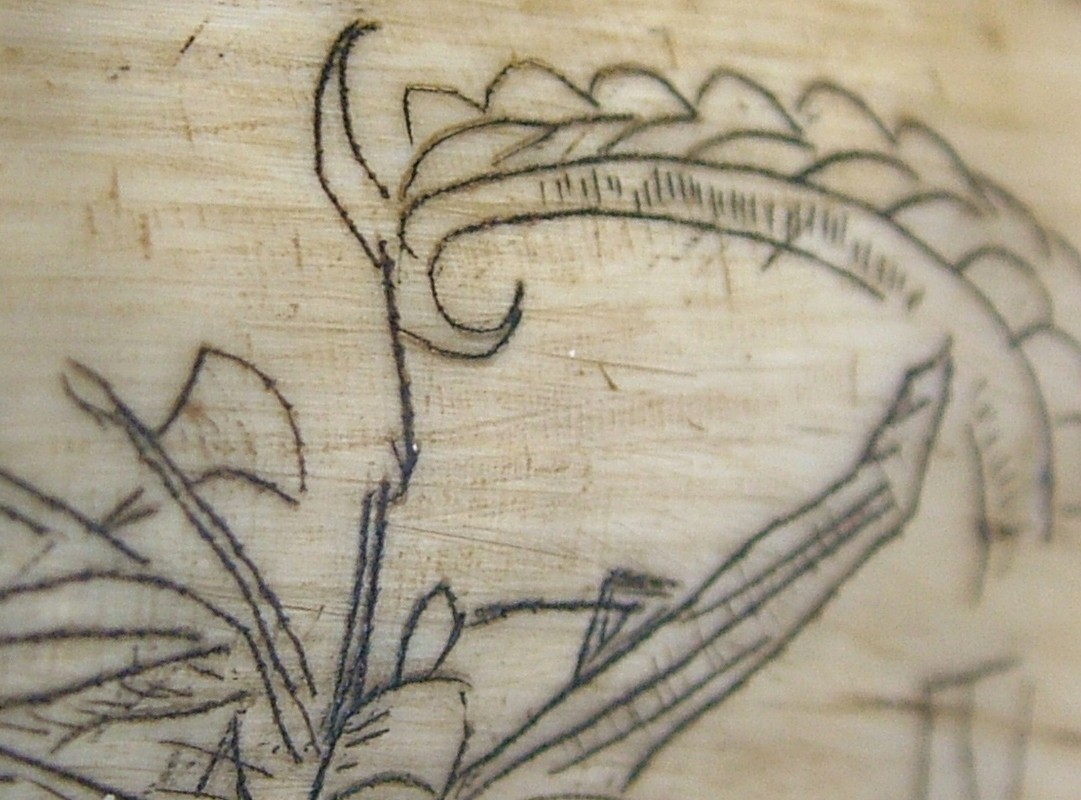
| Photo Copyright 2008 |
| David Xavier Kenney |
|
ADDITIONAL INFO/PICTURE GROUP 1
This is the first group of detail pictures: Pictures 1 and 2 show the right nautical laurel as a type of canopy. There is an axe and a bayonet. There are figures on the axe head and the date "1812". In very light work there is a boat under the canopy; there are figures near the bayonet. Pictures 3 and 4 show that the dates on the axe head are now a letter "P" and an "83". Most likely the "P" is for Philadelphia and the "83" is for the year 1783 and the victorious American conclusion of the Revolutionary War. Pictures 5 and 6 show a figure near the top of the axe head; it has a tri-cornered hat that is also a "W". This should stand for General George Washington. Picture 7 shows that this same figure has changed; it is now as if the figure is looking forward. Pictures 8 and 9 show the area seen in Pictures 1 and 2 as if it is enclosed; the upright bayonet is symbolic of a defensive action. Picture 10 shows a figure stretched over to the cannon knob. There is a prone figure to the right; this figure has a crossbow, under which is the letter "D". All this symbolism has do with the Revolutionary War and Washington Crossing the Delaware in 1776, but then it will change to the actions of the Chesapeake Flotilla in 1814. Pictures 11 and 12 show the detail of the bayonet in this position. There are various faces and figures on this. Pictures 13 and 14 show a figure on a long necked dragonesque type of horse; this figure is holding a lance. One view shows that it is a woman. This figure is facing a group in a boat, in front of the boat is a cross that also forms the letters "J' and "B". The rider should be a combination of Britannia, St. George, and a dragon. It most likely represents the British Fleet (the flag ship was named 'The Dragon") sent to destroy the Chesapeake Flotilla. The boat, figures, and JB-cross should represent Commodore Joshua Barney and the Chesapeake Flotilla. Pictures 15 and 16 show closer detail of each of these. Picture 17 shows a figure that is a combination of smaller figures and faces; these are most likely historical barbarian leaders. Pictures 18 and 19 show the nautical laurel and the artillery hitch as a woman in a crested helmet with a hand to her forehead; there is no doubt that this is Britannia receiving a headache from the Americans. Picture 20 shows the figure in Picture (??) now as a figure being attacked from behind by a dog. Pictures 21 and 22 show the nautical laurel as a Roman War Ship being stopped by the bayonet; the axe is swinging towards this from behind the bayonet. There is a number 4/boat/arm/hand which appears to be grabbing the cannon knob that is now a hangman's noose. Picture 23 shows a close up of the bayonet and Picture 24 shows a close up of the number 4/boat/arm/hand and the hangman's noose. From the Revolutionary War to the mid-19th C. many Americans associated the British with Imperial Rome as an oppressor. The number 4 should stand for the British 4th Regiment (Kings Own). This part of the scrimshaw may have been made in anticipation of the Chesapeake Flotilla engaging the British, or it may have been made after the fact as propaganda, or it may be of the Battle of North Point
|
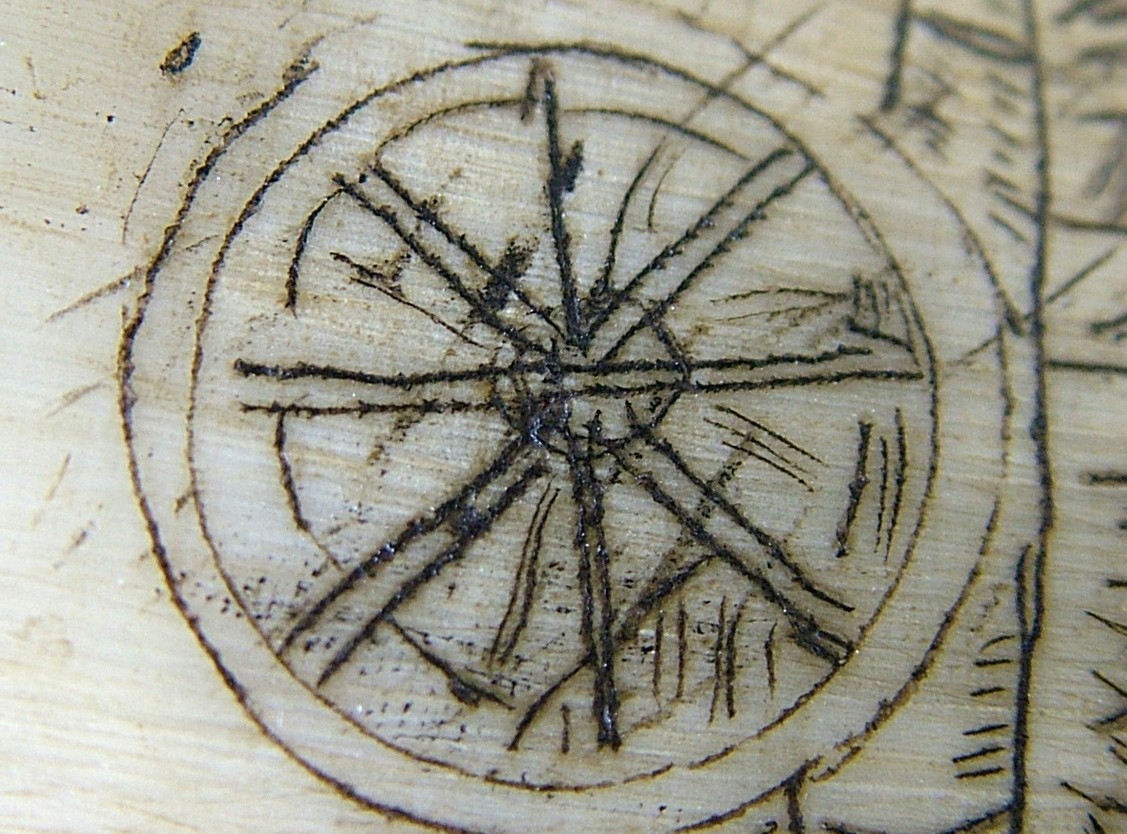
| Photo Copyright 2008 |
| David Xavier Kenney |
|
ADDITIONAL INFO/PICTURE GROUP 2
Pictures 1 and 7 show the wheel and various details of the field cannon on the back of the Powder Horn. This area has an immense amount of miniature art. At a glance much of this may seem crude, but considering some of the excellent micro miniature art on the bottom with the Arthurian theme, I assure you that it was purposely made this way to disguise its symbolism. As with most of the themes on this piece, they overlap. The wheel is the central theme on this side of the powder horn. The art was made to change when moved, and the main message from this view requires that the object be turned clockwise starting at about 9 o'clock. In all positions the wheel can be seen as also being a British flag. The axle of the wheel has many small figures; these represent activity of the artillery batteries in and around Ft. McHenry. The lower half shows the face of a woman in a scarf; to the right is a flask bottle that hints at a woman's body. The face as a flask top and the flask should represent an opened cosmetic powder flask or perfume flask of St. Barbara the patroness of artillerymen. The "powder or perfume of St. Barbara" must have been slang for cannon charges. Pictures 8 thru 10 show the wheel and details in its rightful position on the piece; the axle now shows a face. It has an artilleryman aiming and another overhead giving an order to fire. To the lower right there is a dotted figure; it is a soldier in a shako. Pictures 11 thru 13 show that when this is slightly turned, it shows the following: the axle now shows a face below a fez hat; diagonally under this is the number "18", the letter "M", a letter "C" (that is also a "0"), and the number "5". This may stand for McHenry (although then Ft. McHenry was usually written as M'Henry), but it also stands for "18 Marine Corps 05", meaning the Marine Corps of 1805. This is the year that a detachment of eight Marines took part in the Tripoli Expedition. The soldier's shako has a cross on it, or wavy dagger that has an "8" and an "I' that is also a "T". This should represent the Marines of Marine Barracks of 8th and I Streets of the district of Washington; the "T" should stand for Tripoli. This suggests that at this time at least one Marine at the Marine Barracks had been at the Battle of Derne (popularly known as the Battle of Tripoli) nine years earlier. Picture 14 shows a line figure poking a pike in the eye of the face wearing a fez. This should represent the taking of Derne and the victory over the Barbary pirates. This was the first action taken by American forces on foreign land; it is evident that Americans who were more or less always in a defensive position took great pride in their Marines hoisting an American flag on foreign soil for the first time*. The reaon why some American sailors may have associated the Barbary pirates with the British, is that the Barbary pirates were keen on taking Christian sailors for slaves and ransom, while as the British had a practice of boarding American ships as to take sailors for impressment (conscription) into their Navy. The British impressment of thousands of American sailors was a primary reason for the American declaration of war in 1812. Picture 15 shows that the axle is now the face belonging to a standing male figure in a robe. Pictures 16 thru 19 show the figure as if kneeling; over this figure is a diagonal flag as if being raised. Under him is a large letter "N". This should represent King George III (the Mad King) as the Roman Emperor Nero; he is holding a scepter that at its bottom has a small flag with a snake on it (most likely this is the Revolutionary War "Don't Tread On Me" flag). He now appears to have one eye, perhaps representing a cyclops; the flag on top now shows that it has a number 13 on it (the 13 Colonies of the Revolutionary War). Pictures 23 and 24 show the figure is now almost horizontal. Near the bottom there are two very small figures who appear to be holding a long pike and poking the large figure's eye. Next to this there is one very small figure who is portrayed as if holding a long rope attached to the large figure's nose. Picture 25 shows that the two very small figures are pulling the large figure down with a long white rope that is around the large figure's neck. It is evident that the flag gets hoisted as the large figure (Mad King George as Nero) is pulled down. Pictures 25 and 26 show the detail of the axle and the flag from this position. The axle area shows a cannon being fired. The flag shows a broken ship. On the flagstaff there is a sailor; in front and below him there is either one or two lightly made figures in tri-cornered hats in profile; just above these is a facing female figure. The flag with the broken ship represents the scuttled ships that the Americans used to block the British Fleet's entrance to the Baltimore harbor. The figure or two figures by the sailor most likely represent either John Paul Jones in the singular, or John Paul Jones and his 1st Lt. Richard Dale at the battle of the Bon Homme Richard and the Serapis in Sept. of 1779. This is the battle where Jones gave his famed reply "I Have Yet Begun To Fight".
* The Tripoli expedition was the real beginning of the Marine Corps legacy as a premier fighting force, that is even though the expedition was led by Consul William Eaton, a diplomat posted to Tripoli. Eaton was a Sgt. in the Revolutionary War and later gained a commission as a Capt. in the US Legion (the American Army of the Late 18th C.). His Tripoli expedition consisted of 8 Marines and 500 mercenaries (at the Battle of Derne they would be supported by 3 American warships); and although he was commissioned as a Naval Agent he styled himself as an Army General. In my opinion because of this the American Army felt compelled not to reward him later with a "hasty commission", perhaps with a rank of Col., therefore his second in command Marine Lt. Presley O'Bannon with his seven enlisted Marines were touted with much of the credit. Either way, Eaton's Tripoli expedition is considered a model for modern desert warfare.
|
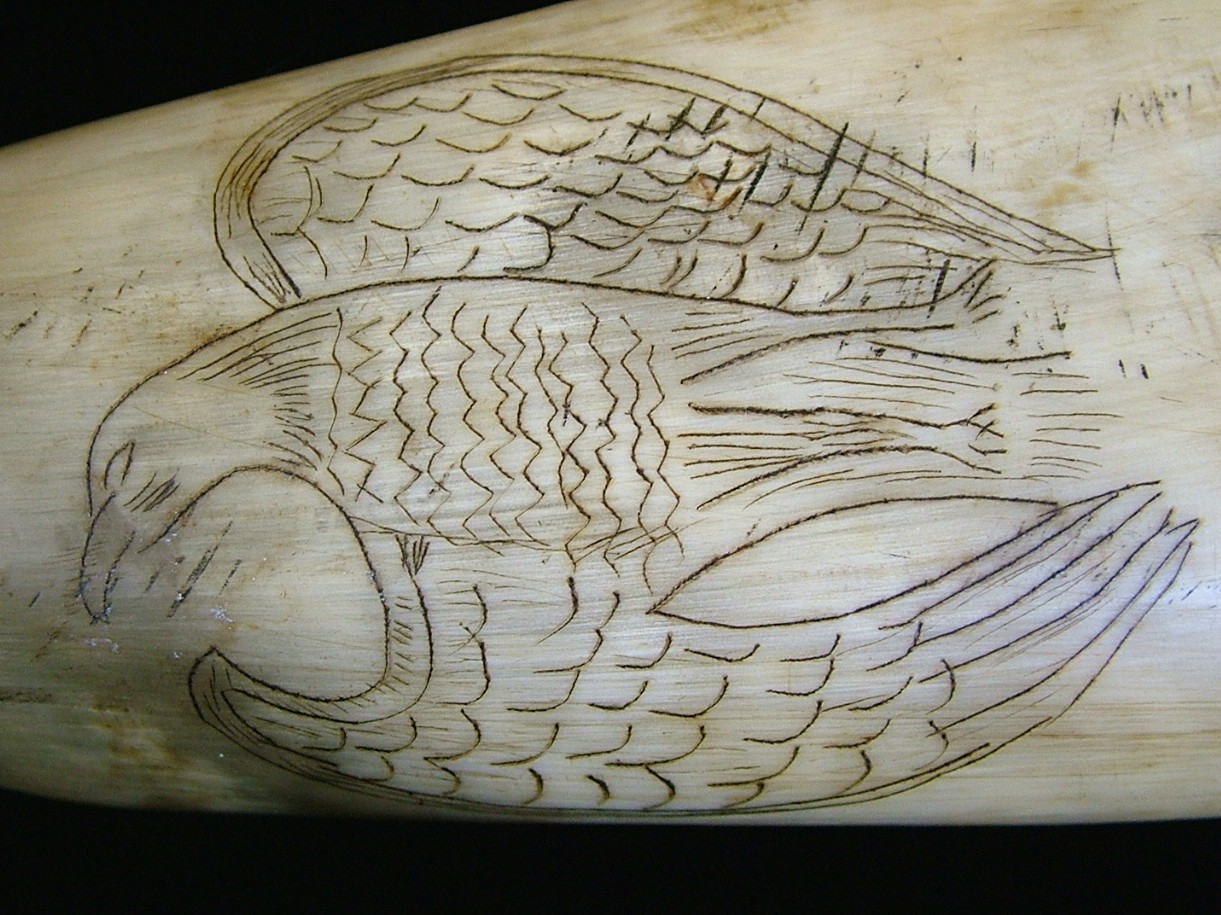
| Photo Copyright 2008 |
| David Xavier Kenney |
|
ADDITIONAL INFO/PICTURE GROUP 3
Picture 1 shows the eagle on the front of the Powder Horn, it is on its side. There is a barrel on it;s side that appears as a torpedo (a 19th C. term for a Naval mine) with the eagle's top leg and claw as a pipe detonator; the eagle's top wing is a shrimp. The shrimp may not seem significant, but it is, as a shrimp's smaller claw can make a snapping noise; colonies of shrimp are some of the noisiest creatures in the oceans. Certain types of shrimp are known to interfere with Naval mine seeking sonar. The theme with this suggests that it is not outside the realm of possibility that the owner of this powder horn had either conceptualized, knew of, or had created a mine that could be detonated by a colony of shrimp. Pictures 2 thru 5 show what may be Washington's Crossing of the Delaware, but it may also show the eagle's beak as a type of detonator. Picture 6 shows a bird (most likely an eagle or a hawk) with the barrel underneath; it is as if the bird is clutching the barrel. The bottom wing is similar to what one would see of a hilly landscape from an aerial view. This theme suggests a small aerial bomb delivered by a bird, but yet the lines near the eagle's beak suggests that the bomb was to be released and detonated from the ground. Pictures 7 thru 12 show details of what once again may be a detonation device on the eagle's beak. It is likely that this was nothing more than a symbolic concept, but then the inventor "may" have discovered something that has yet to be known. Pictures 12 thru 25 show: a boat, or a semi-submergible boat, or a submarine in a hidden sea cavern. This again may have been just a concept, but it may have been a sea craft that was actually scheduled to be built.
|
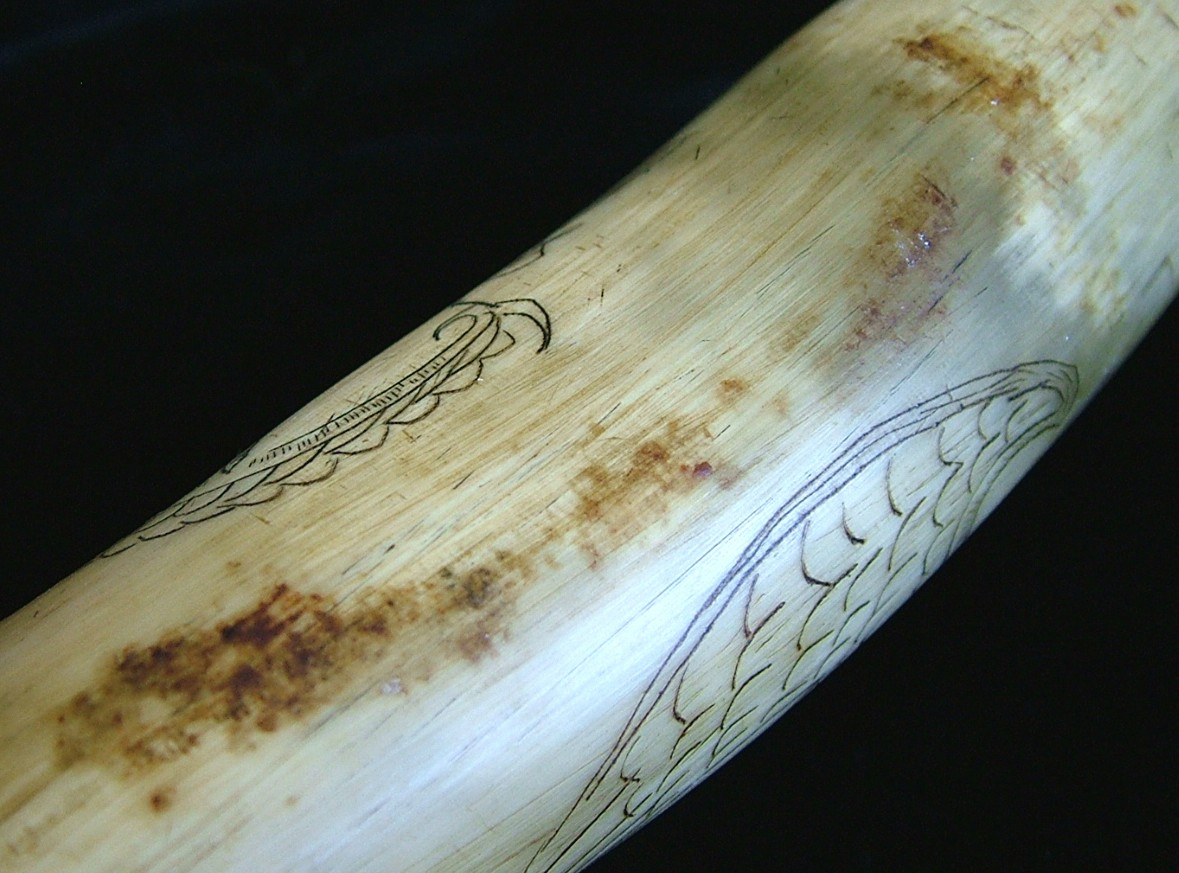
| Photo Copyright 2008 |
| David Xavier Kenney |
|
ADDITIONAL INFO/PICTURE GROUP 4
Picture 1 shows a side of the Powder Horn. Pictures 2 thru 5 shows a figure in a stocking hat; in his nose there is a white nose ring. He is holding what appears to be a cup in the prow of a boat. According to my artifact information this should represent an ancient navigator with a water cup compass. Pictures 6 and 7 show a figure riding on a bear. Pictures 6 thru 19 concern the Chesapeake Bay Flotilla and the Marines of the Battle of Bladenburg. Picture 13 shows an abbreviation for Chesapeake; only the "PEK" shows clearly. It shows that at least to the individual who made the art that these two units were viewed as the "Wall Of Washington" (as in the "Wall of the City in the District of Washington") and the "Sword Of Washington" (as in the "Battle Sword of General George Washington"). The pictures show a figure in a shako with a smaller figure in a shako that is also a hanger styled sword hilt. The tip of the eagle's wing now appears as a beaver's or a seal's head. Pictures 14 and 15 show that the smaller sword hilt figure has the letters "ARK" written on it and also a "B" (that may also be seen as an "8", and or a "3"). A "B" and a "3" may suggest that the defenders of Ft. McHenry were also seen as the "Sword of Washington"; this will be explained at a later date. The figure also has an arm that is taking a sword; the sword is also a compass needle. There is a female in a scarf and the tip of the eagle's beak forms what appears to be the head of a polar bear or a type of large cat. This appears to be referencing a tooth of that animal, which should be another reference to an ancient water cup compass. It would appear that some thought of Washigton's battle sword as the "compass needle of the American nation". Pictures 17 thru 19 show two or three creatures emitting from the eagle's beak, as if moving towards the sword's guard; these are similar to those seen on the "S" guard on George Washington's famed hanger styled battle sword.
The American defeat at the Battle of Bladenburg and the burning of Washington DC in 1814 was the most shameful display in America's history; it became known to the British as the "Bladenburg Races". For the political leadership it is evident that most in authority had failed the rest. Militarily many in authority also failed, there is no doubt that there were not enough regulars and that the militiamen were not up to the task, but there was at least some redemption. This was mainly due to the leadership and planning of Commodore Joshua Barney with his Chesapeake Bay Flotilla. Prior to the battle his fleet of Naval auxiliaries had effectively harried the British until they could no more. After burning their ships, boats, and barges to prevent capture they took on the role of Blue Jackets (sailors as infantrymen) and together with approx. 120 Marines of the Washington Marine Barracks (commanded by Capt. Samuel Miller) they fought the British as a thin blue line of infantrymen and artillerymen. They were outnumbered ten to one (4 to 500 against 5,000). This last ditch part of the battle went on for a time; this included the use of cutlasses. After they had exhausted their ammunition (their ammunition packs had fled with the others in the rout) they retired in an orderly fashion and went on to various destinations in Baltimore to continue to fight. Some would arrive at Ft. McHenry; Barney was wounded and captured. The British Army Commander Maj. Gen. Robert Ross put in his report that the Marines and the Flotillamen were his only real fighting at Bladenburg and Washington; of course he had no idea that later in his attempt to take Baltimore he would have a long range meeting with two American sharpshooters. Pvt. Daniel Wells and Pvt. Henry McComas of the 5th Maryland Regiment are credited with killing Ross; both were killed immediately after
|
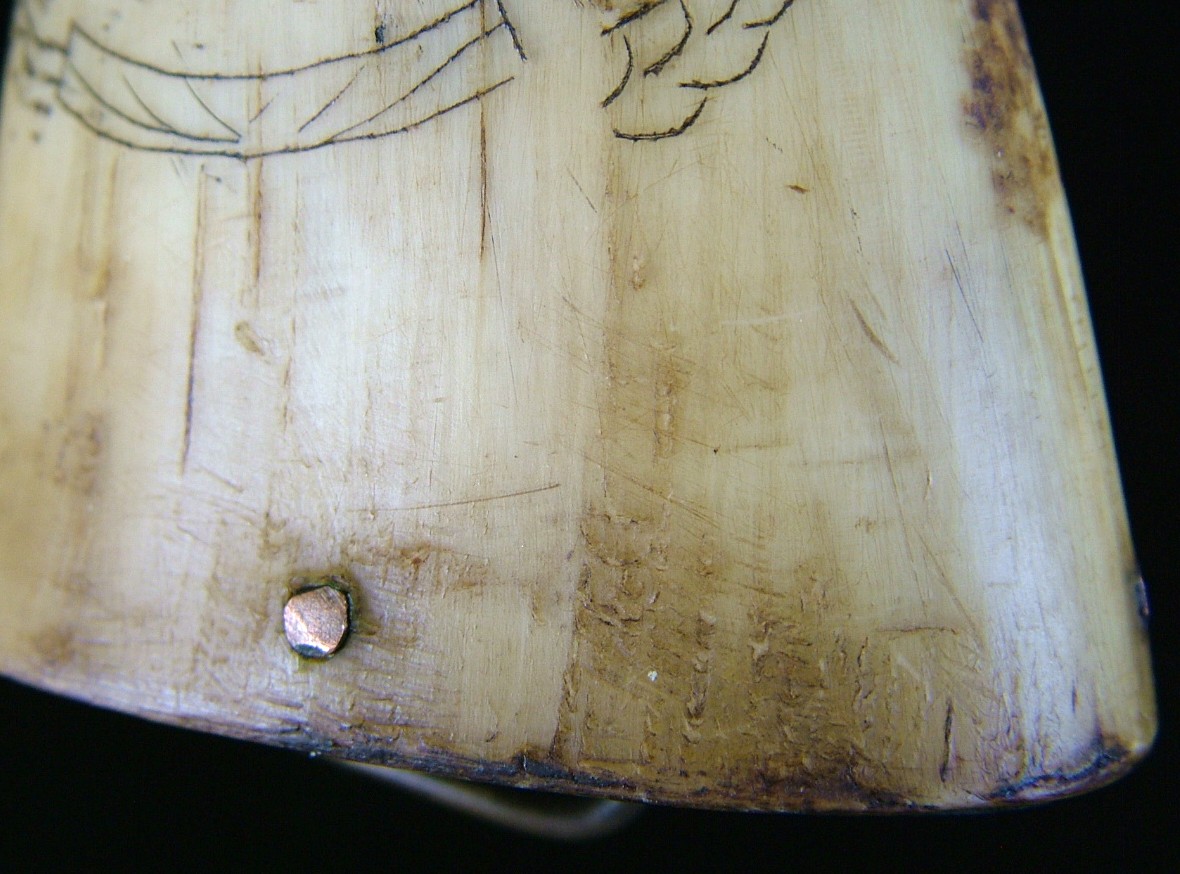
| Photo Copyright 2008 |
| David Xavier Kenney |
|
ADDITIONAL INFO/PICTURE GROUP 5
The pictures with this group focus on the four copper nails on the powder horn. The first three nails appear to have something to do with various European mythological themes. The nail that is on the front (the side with the eagle) has a number 4 on it (this can be seen in Pictures 22 and 23). This should represent the British 4th Regiment (Kings Own); it was the British lead element at the Battle of Baltimore. This was a combined land and sea attack, the sea attack being a naval bombardment of Ft. McHenry. The British met the Americans at North Point, Maryland (Battle of North Point). Just prior to this engagement the British had lost their commander Maj. Gen. Ross at the hands of two American sharpshooters from the 5th Maryland Regiment. Both the Americans and the British fought well, but the British had made at least some gains when towards nightfall they suddenly stopped. The new British commander had decided to wait to see the results of the naval siege. The following day when he saw that Ft. McHenry did not fall he choose to retire his army; in effect it was the beginning of the end for the British in the War of 1812. If the Battle of Bladenburg had been symbolic and retaliatory (for the American burning of the Parliament building at York, Canada; as well as incidents of unsoldierly misconduct there), then the Battle of Baltimore was absolutely strategic, it was expected to be a crucial step in the British winning the war. To the left of the nail on the front there are two ships with a large smoking pipe extended from the prow of the lead ship, the smoking pipe is under the nail. The second ship has a large bearded figure with a "V" over his head; there is a torch (or a spear, or both) behind him. The ships and the figure appear to represent Vikings. This can be seen in Pictures 15 thru 17. Pictures 18 thru 25 show that the smoking pipe is now a club. Picture 19 shows the club with a serpent/dragon that may be a letter "S'. Under this is another smoking pipe, this smoking pipe has a round bowl. The symbolism could be that two American Vikings of the 5th Maryland Regiment had "smoked the British 4th Regiment". In fact the loss of the British commander prior to the main battle (by the two sharpshooters) was one of the reasons why the British retired from the field. I have no idea as to why the 5th Maryland Regiment would have an identification with Vikings, although this may have something to do with George Washington's supposed ancient Norse pedigree and / or the Viking theme on the wooden butt plate.
|
| |
|
|
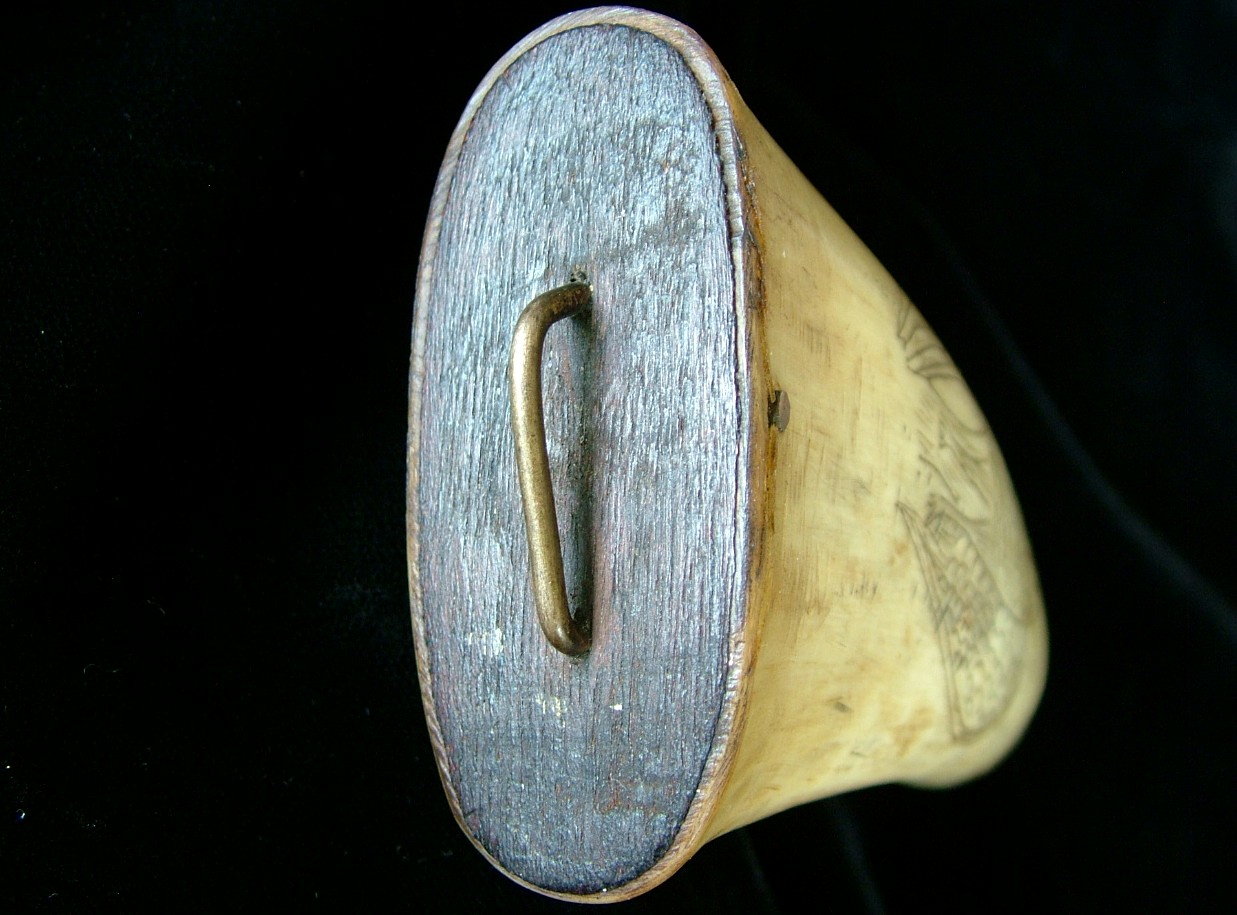
| Photo Copyright 2008 |
| David Xavier Kenney |
|
ADDITIONAL INFO/PICTURE GROUP 6
This group of pictures is of the wooden butt plate, which shows the following: A Commemoration of the Revolutionary War Battle of Trenton and the War of 1812 Siege of Ft. McHenry / Battle of Baltimore. Much of the art is in an overlapping cartoon and/or graffiti style. These sets of pictures were taken under various natural lighting conditions.
|
| |
|
|
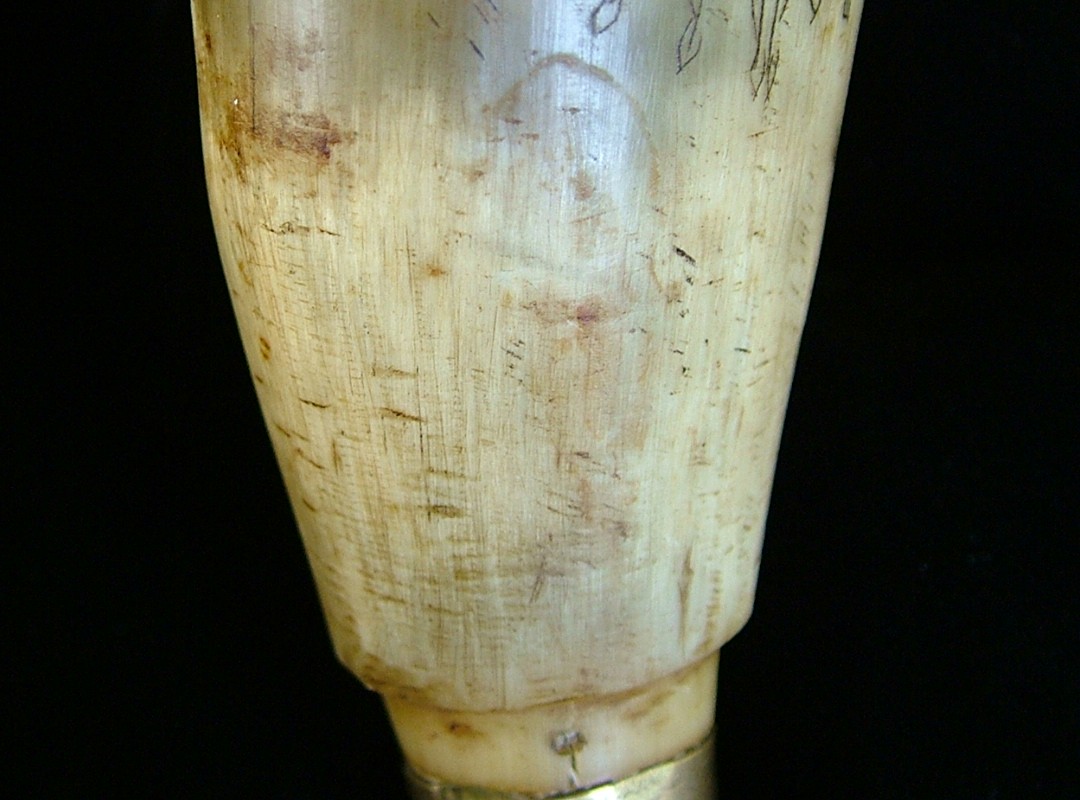
| Photo Copyright 2008 |
| David Xavier Kenney |
|
ADDITIONAL INFO/PICTURE GROUP 7
Pictures 1 and 2 show George Washington in a bicorn hat in profile. This image appears on one side of the Powder Horn when it is held upside down. Pictures 3 to 5 show the wooden butt plate on its side; these pictures were taken with darker natural lighting conditions. They show General George Washington holding open a long piece of paper (much like a scroll). His left hand also appears as a face in a top hat looking toward him; the long piece of paper is also a boat. At second glance one can see that Washington's hat is a bowl with a light orange circle (most likely a star) on top. The white dots on and around Washington suggest a constellation of stars that have a tail; this may also hint of one of the Dippers. There are figures standing behind Washington. Pictures 6 thru 8 show the same images but under lighter natural lighting conditions. With that said, what is different is that in Pictures 6 and 7 there is to the left, a group of soldiers loading from a dock and in small boats. This should represent Washington's troops embarking to cross the Delaware. Pictures 9 thru 14 show what may be Ft. Mc Henry in the area under the brass staple. Pictures 15 thru 19 now show a cannon in the area under the brass staple. Pictures 20 and 21 show figures looking at what may now be a map in the area under the brass staple. Pictures 22 thru 27 show a flag unfolding in the area under the brass staple. There are figures behind this image; the flag appears to be connected to the constellation of stars on the image of Washington. As a matter of fact, the cannon, Ft. McHenry, and the flag/constellation all together suggest that there is a type of transference. Picture 27 also shows that the long piece of paper/boat (in Pictures 3 thru 5) that Washington is holding is also a rocket. When the rocket is combined with the boat it suggests that the artist/inventor "may" have had a concept of using a rocket to power a fast boat. What is a fact, is that Congreve rockets were used during the bombardment of Ft. McHenry; they are referred to in the first verse of "The Star Spangled Banner".
|
| |
|
|
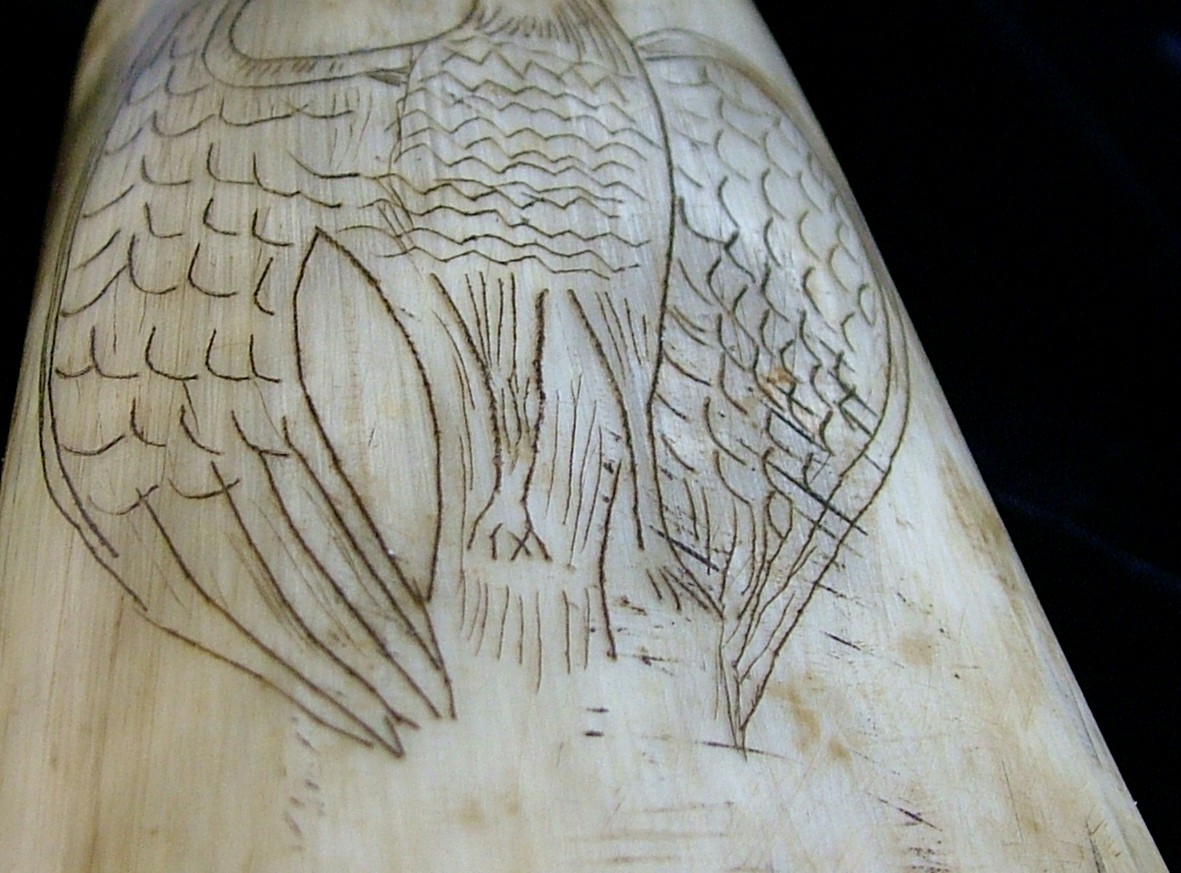
| Photo Copyright 2008 |
| David Xavier Kenney |
|
ADDITIONAL INFO/PICTURE GROUP 8
In Picture 1 you can see that in the eagle's left wing there are figures which appear to be standing and facing to the left. The barrel on the eagle's chest has two small birds or serpents on two wavy lines next to the wavy line at the bottom of the image. Pictures 2 thru 4 direct the viewer from the front of the Powder Horn to the area of interest on the wooden butt plate. Picture 5 shows a blurry figure in long red hair and a top knot. This should represent King Arthur, as according to British legend King Arthur had red hair. This may give the answer to the mystery of the Red "A" that is on the Great Garrison Flag (the Star Spangled Banner) that was flown over Ft. McHenry the morning after the battle. This is the flag that Francis Scott Key referred to when he wrote what would eventually become America's national anthem. I have viewed this flag in pictures and in my opinion it forms the outline of a long red haired man or woman, and the letter "A". As there is at least some Arthurian tradition associated with the city of Baltimore and the state of Maryland, it is very possible that it represents King Arthur victorious. If it is a red haired woman then it most likely has a curse or taunt directed at the British Navy. This would be due to a nautical superstition centered on a sailor seeing a red headed woman in the morning (most likely something to do with the old saying: Red Sky At Night Sailors Delight, Red Sky In The Morning Sailors Take Warning"). Picture 6 shows the brass staple; the longer end is the area of interest with the following pictures. These pictures are in the area where the staple is inserted in the wood. Many are repetitions with different lighting or at various different angles or distances. Picture 7 shows a face in a hat or helmet. Pictures 8 and 9 show various small figures. Pictures 10 thru 15 show a woman holding a narwhal horn downward, it as if it is a wand pointing to an opening; she is looking away and to the left. Pictures 16 and 17 show that the woman is now a man and a woman. The woman is holding a black pearl that is also a child. Picture 18 shows a very small white flower to the lower right. Pictures 19 thru 47 show various scenes of figures that are breaking into, and or taking objects out of a hole that has wooden beams. This is next to where the brass staple is inserted; the hole has various forms in different pictures. There is little doubt that the staple represents a tree, most likely a poplar or hazel tree. Pictures 25 thru 27 show a bearded figure in a conical helmet; it is a Viking. In some of the pictures there is a hint of a bee. This represents Sir George Calvert (later to become Lord Baltimore) and his founding of the Colony of Avalon (Ferryland) in Newfoundland, Canada. It shows that at least some thought that he and his colonists had discovered Viking ruins there, or that the Vikings had found ruins of an earlier group, or both of these.
|
| |
|
|
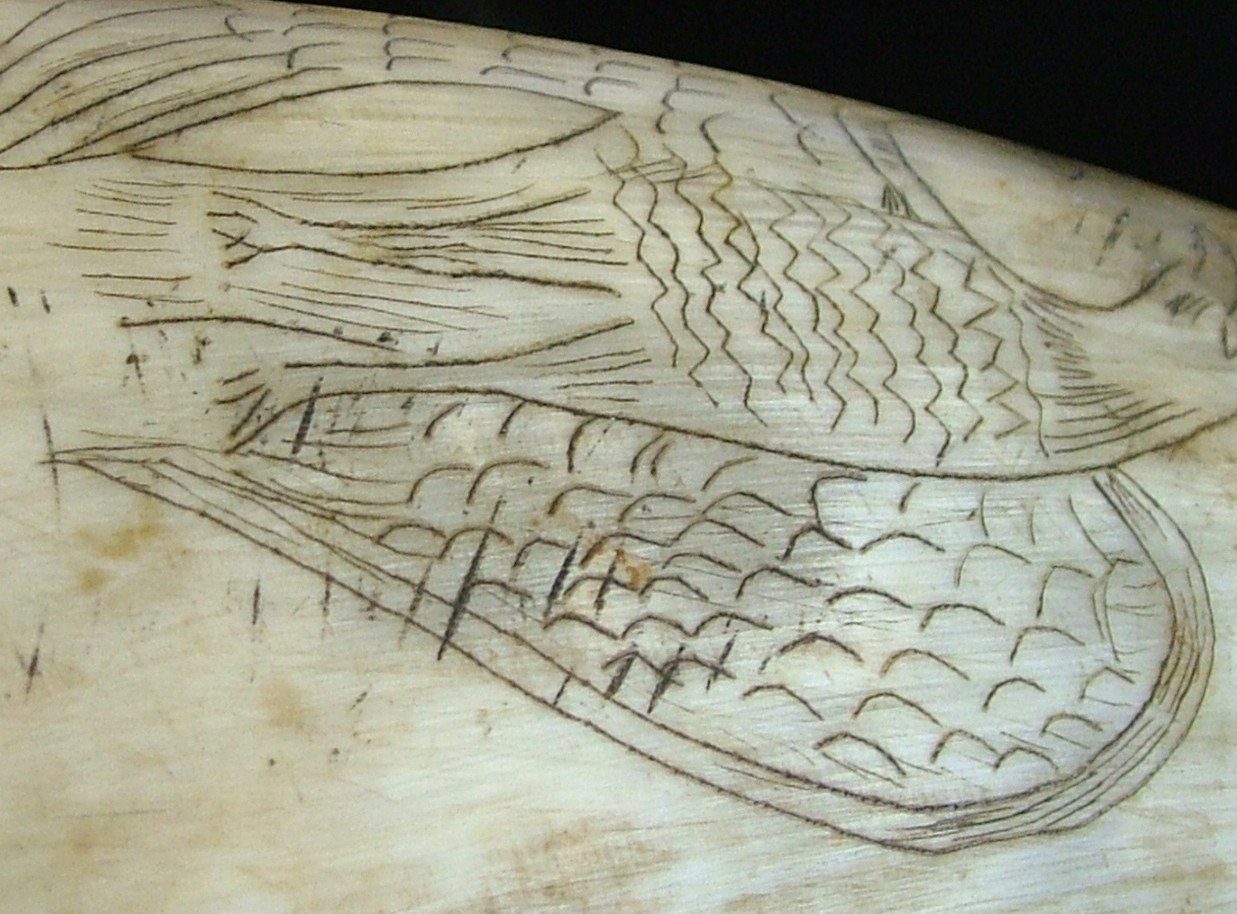
| Photo Copyright 2008 |
| David Xavier Kenney |
|
ADDITIONAL INFO/PICTURE GROUP 9
Pictures 1 thru 4 show the left wing of the eagle on the Powder Horn. It is a bird that is also a type of enclosed ship. This may represent the ships the Ark and the Dove that Lord Cecil Baltimore's colonists arrived in from England in 1634. Pictures 5 thru 7 show the detail of the eagle's wing; there may or may not be more symbolism contained in this. Picture 8 shows the wooden butt plate upside down; the smaller end of the brass staple and the area below is the focus of this last group of pictures. Pictures 9 thru 11 show various small figures. Pictures 12 and 13 show a squirrel and a bird with a letter "C" on it. Picture 14 shows a letter "X" and what may be an Irish wolfhound. Pictures 15 and 16 show a helmeted figure on a horse. In front of this is a figure chasing a goose or a duck. On the other side of the staple there is a face in a hood (that may also be a hut). Behind the hooded face is an upright sickle type sword. Pictures 17 thru 20 show a large withered face, behind this is a bald headed figure with a red ball on his head. To the right is a nude figure holding up a plant shoot (this may also be a green sword blade). There is a full moon in the background. Pictures 21 thru 25 show a wooden plaque leaning on the staple end (tree). There are figures or branches on each side; in front of this is a sword in the ground, only the hilt and a small amount of the blade are showing. There is a full moon in the background. On the other side of the staple (tree) there is a reptile or dragon head with a snake on it. Pictures 26 thru 28 show a ring sword hilt in front of a round container that is on the staple (tree). It suggests a mirror or a water container used for scrying (gazing at a smooth surface for divination purposes). Picture 29 shows an upright curved sword. Picture 30 shows a stick in the ground, a round container on the staple (tree), and a pearl on the other side. Picture 30 shows a figure next to a horse's head. In front of this is a stick in the ground; next to the stick is an inscription that reads as "MOC", or M0C, or perhaps "M9C". Behind this and on the staple (tree) there is a figure holding an "A". Picture 31 and 32 show figures on the plaque, there are other figures under these, all these figures appear to be inanimate. Over to the right there is a long very thin bearded figure holding a small round cup towards the inanimate figures on the bottom. All this suggests that the tall very thin figure is Joseph of Armithea holding the Nanteos Cup. Pictures 34 and 35 show that all the figures now appear as being animate. Pictures 36 thru 40 show a sprig with roots, it appears as if on a grave site. This sprig should be a Cutting from the Tree of Thorns. Picture 41 shows the piece tilted. There are figures and a distinct letter "A". Pictures 42 and 43 show the piece tilted more; there are figures on the staple (tree). Over these there is a larger figure that is holding a drinking horn. Picture 44 shows the piece even more tilted; this shows more or less the same figures. Picture 45 shows the piece upside down; it also pretty much shows the same. Pictures 46 thru 49 show the piece on its side, there are various figures, although Pictures 46 and 47 show a distinct number 14. This most likely stands for the year 1814. All of this shows the following: The founding of the Colony of Maryland by Sir Cecilius (Cecil) Calvert (the 2nd Lord Baltimore), and the House of Baltimore's Arthurian tradition. Besides King Arthur and his sword this includes: Joseph of Armithea, the Nanteos Cup, and a planting of a Cutting from the Tree of Thorns.
Copyright 2008 David Xavier Kenney
Revised Sept 09
|
| |
|
| |
|
